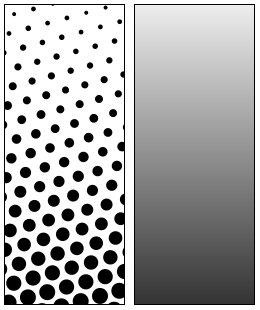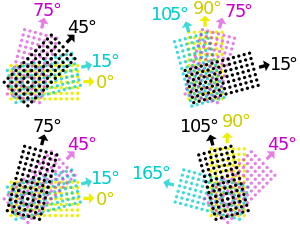Halftone

Halftone is the reprographic technique that simulates continuous tone imagery through the use of dots, varying either in size or in spacing, thus generating a gradient-like effect.[1] "Halftone" can also be used to refer specifically to the image that is produced by this process.[1]
Where continuous tone imagery contains an infinite range of colors or greys, the halftone process reduces visual reproductions to an image that is printed with only one color of ink, in dots of differing size (amplitude modulation) or spacing (frequency modulation). This reproduction relies on a basic optical illusion: the tiny halftone dots are blended into smooth tones by the human eye. At a microscopic level, developed black-and-white photographic film also consists of only two colors, and not an infinite range of continuous tones. For details, see film grain.
Just as color photography evolved with the addition of filters and film layers, color printing is made possible by repeating the halftone process for each subtractive color—most commonly using what is called the "CMYK color model".[2] The semi-opaque property of ink allows halftone dots of different colors to create another optical effect—full-color imagery.[1]
History

William Fox Talbot is credited with the idea of halftone printing. In the early 1830s, he suggested using "photographic screens or veils" in connection with a photographic intaglio process.[3]
Several different kinds of screens were proposed during the following decades. One of the well known attempts was by Stephen H. Horgan while working for the New York Daily Graphic. The first printed photograph was an image of Steinway Hall in Manhattan published on December 2, 1873.[4] The Graphic then published "the first reproduction of a photograph with a full tonal range in a newspaper" on March 4, 1880 (entitled "A Scene in Shantytown") with a crude halftone screen.[5]
The first truly successful commercial method was patented by Frederic Ives of Philadelphia in 1881.[3][5] Although he found a way of breaking up the image into dots of varying sizes, he did not make use of a screen. In 1882, the German Georg Meisenbach patented a halftone process in England. His invention was based on the previous ideas of Berchtold and Swan. He used single lined screens which were turned during exposure to produce cross-lined effects. He was the first to achieve any commercial success with relief halftones.[3]
Shortly afterwards, Ives, this time in collaboration with Louis and Max Levy, improved the process further with the invention and commercial production of quality cross-lined screens.[3]
The relief halftone process proved almost immediately to be a success. The use of halftone blocks in popular journals became regular during the early 1890s.[3]
The development of halftone printing methods for lithography appears to have followed a largely independent path. In the 1860s, A. Hoen & Co. focused on methods allowing artists to manipulate the tones of hand-worked printing stones.[6] By the 1880s, Hoen was working on halftone methods that could be used in conjunction with either hand-worked or photolithographic stones.[7][8]
Traditional screening
The most common method of creating screens—amplitude modulation—produces a regular grid of dots that vary in size. The other method of creating screens—frequency modulation—is used in a process also known as stochastic screening. Both modulation methods are named by analogy with the use of the terms in telecommunications.[9]
Resolution of halftone screens
| Typical halftone resolutions | |
| Screen printing | 45–65 lpi |
| Laser printer (300dpi) | 65 lpi |
| Laser printer (600dpi) | 85–105 lpi |
| Offset press (newsprint paper) | 85 lpi |
| Offset press (coated paper) | 85–185 lpi |
The resolution of a halftone screen is measured in lines per inch (lpi). This is the number of lines of dots in one inch, measured parallel with the screen's angle. Known as the screen ruling, the resolution of a screen is written either with the suffix lpi or a hash mark; for example, "150 lpi" or "150#".
The higher the pixel resolution of a source file, the greater the detail that can be reproduced. However, such increase also requires a corresponding increase in screen ruling or the output will suffer from posterization. Therefore file resolution is matched to the output resolution.
Multiple screens and color halftoning


When different screens are combined, a number of distracting visual effects can occur, including the edges being overly emphasized, as well as a moiré pattern. This problem can be reduced by rotating the screens in relation to each other. This screen angle is another common measurement used in printing, measured in degrees clockwise from a line running to the left (9 o'clock is zero degrees).
Halftoning is also commonly used for printing color pictures. The general idea is the same, by varying the density of the four secondary printing colors, cyan, magenta, yellow and black (abbreviation CMYK), any particular shade can be reproduced.[10]
In this case there is an additional problem that can occur. In the simple case, one could create a halftone using the same techniques used for printing shades of grey, but in this case the different printing colors have to remain physically close to each other to fool the eye into thinking they are a single color. To do this the industry has standardized on a set of known angles, which result in the dots forming into small circles or rosettes.
The dots cannot easily be seen by the naked eye, but can be discerned through a microscope or a magnifying glass.
Dot shapes
Though round dots are the most common used, there are different dot types available, each of them having their own characteristics. They can be used simultaneously to avoid the moiré effect. Generally, the preferred dot shape is also dependent on the printing method or the printing plate.
- Round dots: most common, suitable for light images, especially for skin tones. They meet at a tonal value of 70%.
- Elliptical dots: appropriate for images with many objects. Elliptical dots meet at the tonal values 40% (pointed ends) and 60% (long side), so there is a risk of a pattern.
- Square dots: best for detailed images, not recommended for skin tones. The corners meet at a tonal value of 50%. The transition between the square dots can sometimes be visible to the human eye.[11]
Digital halftoning
Digital halftoning has been replacing photographic halftoning since the 1970s when "electronic dot generators" were developed for the film recorder units linked to color drum scanners made by companies such as Crosfield Electronics, Hell and Linotype-Paul.
In the 1980s, halftoning became available in the new generation of imagesetter film and paper recorders that had been developed from earlier "laser typesetters". Unlike pure scanners or pure typesetters, imagesetters could generate all the elements in a page including type, photographs and other graphic objects. Early examples were the widely used Linotype Linotronic 300 and 100 introduced in 1984, which were also the first to offer PostScript RIPs in 1985.[12]
Early laser printers from the late 1970s onward could also generate halftones but their original 300 dpi resolution limited the screen ruling to about 65 lpi. This was improved as higher resolutions of 600 dpi and above, and dithering techniques, were introduced.
All halftoning uses a high frequency/low frequency dichotomy. In photographic halftoning, the low frequency attribute is a local area of the output image designated a halftone cell. Each equal-sized cell relates to a corresponding area (size and location) of the continuous-tone input image. Within each cell, the high frequency attribute is a centered variable-sized halftone dot composed of ink or toner. The ratio of the inked area to the non-inked area of the output cell corresponds to the luminance or graylevel of the input cell. From a suitable distance, the human eye averages both the high frequency apparent gray level approximated by the ratio within the cell and the low frequency apparent changes in gray level between adjacent equally spaced cells and centered dots.
Digital halftoning uses a raster image or bitmap within which each monochrome picture element or pixel may be on or off, ink or no ink. Consequently, to emulate the photographic halftone cell, the digital halftone cell must contain groups of monochrome pixels within the same-sized cell area. The fixed location and size of these monochrome pixels compromises the high frequency/low frequency dichotomy of the photographic halftone method. Clustered multi-pixel dots cannot "grow" incrementally but in jumps of one whole pixel. In addition, the placement of that pixel is slightly off-center. To minimize this compromise, the digital halftone monochrome pixels must be quite small, numbering from 600 to 2,540, or more, pixels per inch. However, digital image processing has also enabled more sophisticated dithering algorithms to decide which pixels to turn black or white, some of which yield better results than digital halftoning. Digital halftoning based on some modern image processing tools such as nonlinear diffusion and stochastic flipping has also been proposed recently.[13]

See also
- Ben-Day dots
- Dot gain
- Duotone
- Error diffusion
- Mezzotint
- Pulse-width modulation
- Raster image processor (RIP)
- Screentone
- Oversampled binary image sensor
Significant academic research groups
- Electronic Imaging Systems Laboratory at Purdue University
- Embedded Signal Processing Laboratory at UT Austin
References
- 1 2 3 Campbell, Alastair. The Designer's Lexicon. ©2000 Chronicle, San Francisco.
- ↑ McCue, Claudia. Real World Print Production. ©2007, Peachpit Berkeley.
- 1 2 3 4 5 Twyman, Michael. Printing 1770–1970: an illustrated history of its development and uses in England. Eyre & Spottiswoode, London 1970.
- ↑ LIFE. "100 Photographs That Changed the World". Time, Inc. August 25, 2003, p 18.
- 1 2 Meggs, Philip B. A History of Graphic Design. John Wiley & Sons, Inc. 1998. p 141. ISBN 0-471-29198-6.
- ↑ August Hoen, Composition for etching stone, U.S. Patent 27,981, Apr 24, 1860.
- ↑ August Hoen, Lithographic Process, U.S. Patent 227,730, May 15, 1883.
- ↑ August Hoen, Lithographic Process, U.S. Patent 227,782, May 18, 1880.
- ↑ Gaurav Sharma (2003). Digital Color Imaging Handbook. CRC Press. p. 389. ISBN 978-0-8493-0900-7.
- ↑ Halftone Line Screens in Printing "Use of halftone line screens for printing digital images on press". (last checked on 2009-04-20)
- ↑ Kay Johansson, Peter Lundberg & Robert Ryberg, A Guide to Graphic Print Production. 2nd ed. Hoboken: Wiley & Sons, p. 286f. (2007).
- ↑ Linotype History - 1973–1989
- ↑ Shen, Jackie (Jianhong) (2009). "Least-square halftoning via human vision system and Markov gradient descent (LS-MGD): Algorithm and analysis". SIAM Rev. 3. 51: 567–589. doi:10.1137/060653317.
External links
- Web Browser's Guide to Digital Halftoning
- Halftone Screens and Dots
- Dr. Daniel Lau's Website about halftoning
- "The Rasterbator": Software that allows creation of large halftone type posters
- Image Halftoning Toolbox for MATLAB by V. Monga, N. Damera-Venkata and B. L. Evans
- Halftone screens at the Wolfram Demonstrations Project
- Creating halftone shading with Adobe Photoshop
- An Easy Method for Making Custom Halftones in Adobe Photoshop
- A visual guide to traditional halftones and their creation